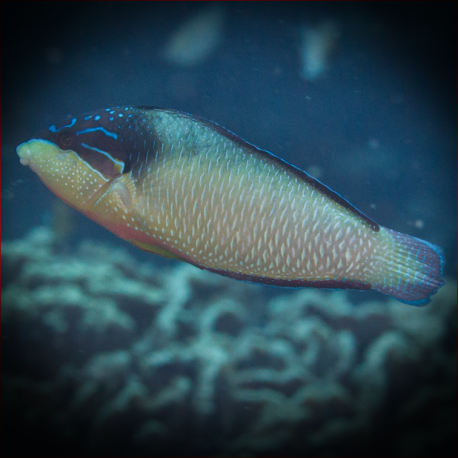More info
Datasheet
| Minimum Tank Size | 500 litres / 132.09 US gallons |
| Maximum Size | 20.0cm / 7.87inches |
| Reef Compatible | Always reef safe |
| Temperament | Docile but might be aggressive towards similar species of same gender |
| Temperature | 22.2°C / 71.96°F - 25.6°C / 78.08°F |
| Specific Gravity | 1.020-1.025 |
| Carbonate Hardness | 8-12 |
| pH | 8.1-8.4 |
General DescriptionSpecies in the genus Anampses, such as the Anampses neoguinaicus, are known for their striking beauty, with marked differences in appearance between males, females, and juveniles. These wrasses are typically peaceful, thrive in small groups, and have a unique behavior of burying themselves in sand when threatened or resting.
Aquarium SuitabilityThe New Guinea wrasse, with the scientific name Anampses neoguinaicus, demands experience, preparation, and extra care for successful care in aquariums. They are delicate and sensitive during transportation, requiring frequent feedings, a deep sandy substrate for burrowing, and can be shy and docile, becoming bolder in peaceful tank setups.
Care and HardinessAnampses neoguinaicus, commonly known as the New Guinea wrasse, is hard to keep alive and thriving, needing live food initially and frequent feedings when mature. They are not typically aggressive towards invertebrates but might succumb to small temptations in the tank. Careful handling during transportation and acclimatization is crucial for their survival.
Reef SuitabilityAlways reef safe, the New Guinea wrasse, or Anampses neoguinaicus, is suitable for reef aquariums due to its peaceful nature and compatibility with invertebrates. It will not pose a threat to most reef inhabitants, making it a popular choice for reef setups.
Aquarium SetupTo cater to the needs of Anampses neoguinaicus, a minimum tank size of 500 liters with a deep sandy substrate of at least 2 inches is recommended. They require ample swimming space and a peaceful tank environment to thrive, with careful consideration for tank mates due to their shy nature.
BehaviourThe New Guinea wrasse exhibits docile behavior but may display aggression towards similar species of the same gender. Their burying behavior in sand serves as a defense mechanism or a way to rest, showcasing their unique adaptation in aquarium settings.
Feeding and DietAnampses neoguinaicus, the New Guinea wrasse, feeds on various invertebrates, small crustaceans like Krill, mysis, and artemia, and zooplankton such as Cyclops and pods. Supplying live food for adaptation is key to their success in aquariums, and their feeding frequency varies based on availability of natural food in the tank.
Habitat and DistributionFound in the Western Pacific region from the Philippines and Taiwan to Fiji, north to the Izu Islands, and south to the Great Barrier Reef and New Caledonia, the Anampses neoguinaicus thrives in diverse marine habitats, showcasing its widespread distribution and adaptability.

